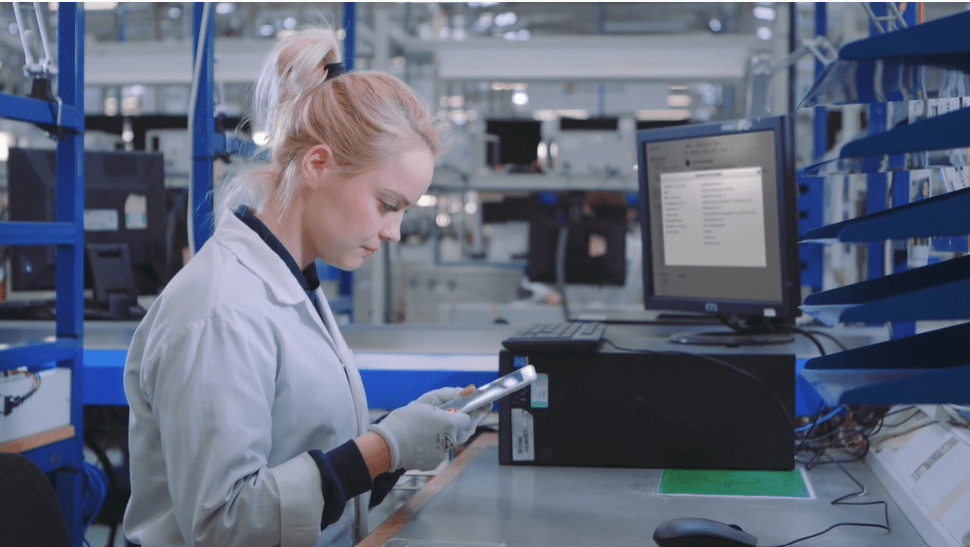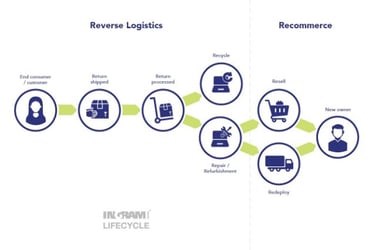As the pressure increases on businesses to change their everyday practices to improve sustainability, reverse logistics does not escape scrutiny. It is a prime area for improving your business environmental footprint.
One way to increase sustainability is through product recycling and refurbishment. Before starting, you need to pre-emptively understand the barriers to achieving this. In knowing the challenges you can better prepare your processes for success.
Ingram Micro Lifecycle works with multiple technology companies around the globe in supporting and strategizing reverse logistics processes. Through these partnerships, we implement lifecycle extension programs that include recycling and refurbishing high-tech electronics, IT and mobility devices, and small domestic appliances.
In this article, we discuss the challenges that businesses typically face when incorporating recycling and refurbishing practices into their business-as-usual functions.
The challenges when introducing lifecycle extension processes
Reverse logistics has come a long way since its inception. Product repair and processing is no longer simply confined to a technician with a screwdriver. It’s as much about materials refinishing as it is about fixing parts.
Why introduce refurbishment
As we touched on in the introduction, businesses need to become more accountable for their sustainability efforts. Through ESG objectives, stakeholders and investors look for business achievements in lowering their carbon footprint. This includes your target market.
Non-environmentally friendly practices, like unnecessary landfill and waste contributions, can quickly damage a brand’s reputation. Products you handle, either through manufacturing, retail, or leasing, must be treated sustainably as a result of your reverse logistics.
Finding a second home for products no longer wanted in their original life is one outcome that is achievable through refurbishment.
Consider any process that enables a circular economy, extending the lifecycle of a device that has residual value or demand, a normal part of your reverse logistics.
These also lower the costs associated with product replacement. Providing a refurbished product as an exchange, instead of new, lowers production costs.
Refurbishing devices also enables recommerce- the recovery of residual value within unwanted products. Use refurbishing technologies to maximize residual value.
The barriers to successful recovery and refurbishment
Understanding economic value
As mentioned above, products will have a residual value. This can dictate whether it’s economically viable to restore its condition through refurbishment, or if it should be sustainably recycled. You may also sell the device as-is without refurbishment, after rekitting and repackaging.
You need to be able to correctly value the product. This information dictates the best outcome, providing you have access to a recommerce network to be able to sell it on. This requires technical experience and equipment to assess a device to give the current product value.
Development of specialist cleaning techniques
To get the best possible outcome from your refurbishment process, you need accurate and efficient techniques that suit the product type(s) that you process. For example, for repairing a scratched or cracked smartphone screen, it’s more sustainable to refinish the glass or replace the top layer, as opposed to installing a completely new screen.
You need the agility to combine refurbishment techniques to problem-solve faulty or damaged products cost-effectively. This also entails having the specialist tools and equipment to complete these processes.
This also needs to be considered as part of the product design process. The materials and parts used to make the product should be serviceable, and created with recycling and refurbishment in mind. For example, what attachment method is used for the parts; glue or screws?
Honouring the original engineering
When refurbishing products, you need to ensure solutions are well thought-through, repeatable, scalable, and automated (where appropriate). This ensures not only the longevity of the process but also honours the OEM quality and standards.
One sure way of achieving this is via OEM accreditations. These provide access to genuine parts, repair manuals, and manufacturer-approved processes. This guarantees the repairs are done to a high standard using methods and facilities that the manufacturer has audited.
Automating for consistency
In line with developing the right techniques for refurbishment, you also have to innovate with AI and robotic automation. These assist with removing unavoidable human biases, adhering consistently to a set of specific criteria, and limiting errors.
You need to be able to invest and be agile in the introduction of these systems to continue developing better ways of refurbishing and recycling products.
Limiting plastic waste
There’s an incredible amount of plastic that goes into landfills because of manufacturing. Packaging is the biggest contributor to plastic waste generation and is predicted to double in volume before 2060. Electrical/electronic plastic waste is also expected to double.
Aiming to decrease your plastic waste supports ESG objectives and boosts sustainability performance, whilst also increasing appeal for eco-conscious consumers.
You need to find solutions and practices that strive to limit the use of plastics, perhaps by refinishing or using more sustainable materials.
Introducing recommerce
It’s a myth that recommerce cannibalizes new product sales and as such, you might face some opposition when trying to add this into your reverse logistics process.
You may need to make the case for its integration. Instead of losing part of your target customer base, you increase your reach to a new demographic by offering products at a different affordability level.
Are you ready to integrate refurbishment and recycling?
Outsourcing your reverse logistics process can diminish the impact of several of these barriers so incorporating the process doesn’t need to consume internal resources or planning. It’s an important factor to consider for the reverse logistics process to limit waste production across the supply chain and lower the pressures on manufacturing.
Ingram Micro Lifecycle can combat these challenges with our wide range of reverse logistics solutions. Our agile and global footprint can support customers wherever they are with solutions tailored to their specific needs and pain points.
Get in touch with us today to have a no-obligation discussion about the reverse logistics challenges your business is facing.
Recommended reading:
- Switching supply from new to refurbished devices? 5 key questions
- 9 technology industry & reverse logistics certifications
- 8 ways 3PL transforms reverse logistics for a circular economy
- How smartphone screen repair promotes sustainability & circularity
- 9 key reverse logistics factors that affect value recovery
- What is recommerce? Definition, benefits, and processes













